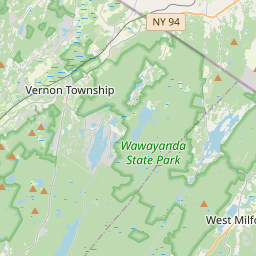The Company Store
Historical marker location:
West Milford, New Jersey
( Marker can be reached from Greenwood Lake Turnpike, on the right when traveling west.)







© OpenStreetMap contributors
Post Office, Hewitt, New Jersey
Loading...
Searching for other points of interest within 3 miles of this location.The United States Army's Fort Dix, located in New Jersey, served as a major training and staging ground for American troops during both World War I and World War II.
About Passaic County
Passaic County Timeline
Passaic County, located in the northeastern part of New Jersey, has a rich and diverse history that spans over several centuries. The area was originally inhabited by Native American tribes, such as the Lenape, who lived off the land and established small settlements along the Passaic River.
The European colonization of the region began in the 17th century when Dutch and English settlers arrived in search of land and trade opportunities. In 1678, the Dutch West India Company obtained nearly all of present-day Passaic County from the Lenape tribes in a land purchase known as the New Barbadoes Tract. The area quickly developed as farmers settled in the fertile valleys, establishing towns and villages.
The Industrial Revolution in the early 19th century brought significant changes to Passaic County. The abundant water power provided by the Passaic River and its tributaries attracted industries such as textile mills, ironworks, and locomotive manufacturing. Cities like Paterson, known as the "Silk City," became centers of industrial production and attracted a wave of immigrant workers from around the world.
Throughout the 20th century, Passaic County continued to grow and evolve. It witnessed significant social and cultural transformations, with the arrival of new immigrant groups and the development of diverse communities. The county also played a role in important historical events, such as the labor movements of the early 1900s and the civil rights struggles of the 1960s.
Today, Passaic County is a vibrant and diverse region, with a mix of urban centers, suburban neighborhoods, and natural landscapes. It is home to a range of industries, educational institutions, and cultural amenities. The county's rich history is evident in its historic sites, museums, and landmarks, reminding visitors and residents alike of the region's past and its contributions to New Jersey's history.
The European colonization of the region began in the 17th century when Dutch and English settlers arrived in search of land and trade opportunities. In 1678, the Dutch West India Company obtained nearly all of present-day Passaic County from the Lenape tribes in a land purchase known as the New Barbadoes Tract. The area quickly developed as farmers settled in the fertile valleys, establishing towns and villages.
The Industrial Revolution in the early 19th century brought significant changes to Passaic County. The abundant water power provided by the Passaic River and its tributaries attracted industries such as textile mills, ironworks, and locomotive manufacturing. Cities like Paterson, known as the "Silk City," became centers of industrial production and attracted a wave of immigrant workers from around the world.
Throughout the 20th century, Passaic County continued to grow and evolve. It witnessed significant social and cultural transformations, with the arrival of new immigrant groups and the development of diverse communities. The county also played a role in important historical events, such as the labor movements of the early 1900s and the civil rights struggles of the 1960s.
Today, Passaic County is a vibrant and diverse region, with a mix of urban centers, suburban neighborhoods, and natural landscapes. It is home to a range of industries, educational institutions, and cultural amenities. The county's rich history is evident in its historic sites, museums, and landmarks, reminding visitors and residents alike of the region's past and its contributions to New Jersey's history.
Passaic County Timeline
This timeline provides a condensed summary of the historical journey of Passaic County, New Jersey.
- 1694 - Passaic County officially established as a county in the Province of East Jersey.
- 1751 - The first courthouse is constructed in Acquackanonk, which is now known as Passaic.
- 1782 - The Great Falls of the Passaic River are harnessed to power Paterson's industrial growth.
- 1791 - The Society for Establishing Useful Manufactures (SUM) is formed, leading to the development of the city of Paterson.
- 1837 - The railroads reach Paterson, stimulating further industrialization and growth.
- 1861-1865 - Passaic County plays a prominent role in supplying troops and munitions during the American Civil War.
- 1871 - The city of Passaic is established as a separate municipality within the county.
- 1917 - The United States enters World War I, leading to increased industrial production in Passaic County.
- 1926 - The town of West Milford secedes from Passaic County to become part of Passaic County.
- 1957 - The Garden State Parkway opens, providing increased access and transportation options for Passaic County residents.
- 1971 - The Passaic County Community College is established to provide affordable higher education opportunities to residents.
- 1992 - The Paterson Museum is designated as a National Historic Landmark, recognizing its significance in preserving the industrial history of the region.
- 2005 - The city of Paterson celebrates its 200th anniversary.